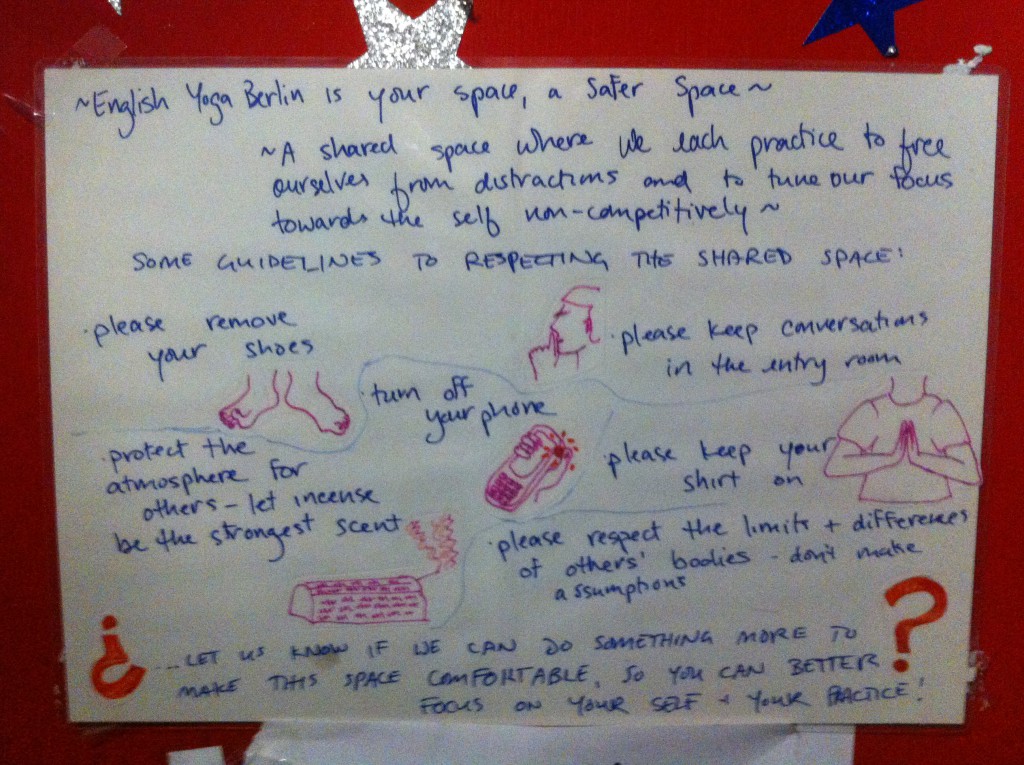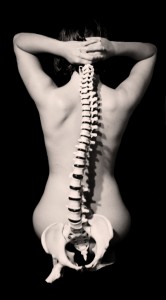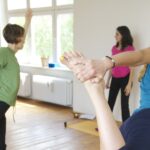As a yoga teacher I often hear from students, “I like yoga, but I’m not good at it.” What I understand from this is that they feel they’re expected to do the poses ‘correctly’ in order to be ‘good at yoga.’ But yoga is not dance. As yoga practitioners, we’re not performing for an audience, but we do yoga in order to feel more ease in our bodies, more calm in the mind. We practice yoga for ourselves and nobody else. True, our practice can extend to others by helping us see how we can help our communities. But the practice of yoga is not a show.
“Yoga is not a competition”
The media tells us something different. Yoga competitions are springing up all over the world. The covers of Yoga Journal and Sein show us mostly white, mostly slim, mostly cis-female flexible yogis demonstrating their fanciest poses. Yoga teachers tell us; “there is no right or wrong way to do yoga,” and “yoga is not a competition,” and “everyone has a different body.” But I’ve also heard yoga teachers say that their students are not doing the poses ‘correctly.’ In a yoga class, the teacher will offer corrections with the primary goal of preventing the practitioner from injuring themselves in the pose. But sometimes, subconscious biases causes a teacher to ‘correct’ a student’s pose so that it looks like the textbook or covermodel version, pressing a student to go beyond their own limits, and throwing them out of awareness of their own body. This can not only lead to physical injury, but can also inadvertently cause a student to feel as if they’re ‘not good at yoga.’ As a teacher, I’m always looking to find that balance to gently encourage students to find their limits and go further if they feel like it that day, or retreat from it if they need to. Sometimes this means I do not do corrections at all, especially for those new to yoga. I like to let new practitioners find their own way of doing the poses. Though I myself really like the feeling of an experienced teacher’s gentle guiding hand encouraging my shoulder blades to release down my back, so I don’t want to do away with it altogether. Maybe we even need to move away from a terminology that refers to something as a ‘correction’ and instead call these gentle encouragements something else? What would work for you? Assistance? Encouragements? Guidance?
At English Yoga Berlin, we have consent cards at the fronts of each mat with YES on one side and NO on the other, that lets the teacher know if a participant would like to be touched or not. Participants are invited to turn it over at any point in the class.
Yoga is not Dance
A regular practice of yoga can be good for dancers to balance the stresses they put on their bodies. But it can also be good for those of us who put our bodies through stress in other ways – doing manual labour such as caring for small children, cleaning or construction work, or doing immobile work without a break such as sitting at a computer desk for 8 hours every day or driving a truck for 36 hours. Human bodies need to move, we need to strengthen and limber up our bodies to create more ease in our everyday lives, to recuperate from our daily stresses. This is how a regular practice of yoga benefits us. I can understand how yoga is popular amongst dancers. But when people who have never had dance training come to yoga, and they see a dancer at the front of the room, or amongst them in the practice space, it may cause feelings of inadequacy. How can we, as yoga teachers, and how can we, as experienced yoga practitioners, make room for those new to yoga to feel comfortable?
At English Yoga Berlin, we also have a sign with guidelines as to how we would appreciate everyone act in the space. As the yoga space is for everyone, we hope to provide a space where everyone can feel comfortable. For us, this means that we respect others’ practice by not showing off, flaunting our privilege, wearing strong perfume or chatting in the practice room. Is there anything else that would help you feel more comfortable?

English Yoga Berlin – Safer Space Guidelines
Juli offers Community Yoga classes at English Yoga Berlin, with an emphasis on creating a space for those who feel marginalized by mainstream yoga classes: sliding scale prices for no- / low-income earners. Juli teaches Vinyasa Flow Yoga and Restorative Yoga and is currently enrolled in the Svastha Yoga Therapy advanced teacher training program and has completed the first two modules, yoga for injuries and illnesses of the body.







